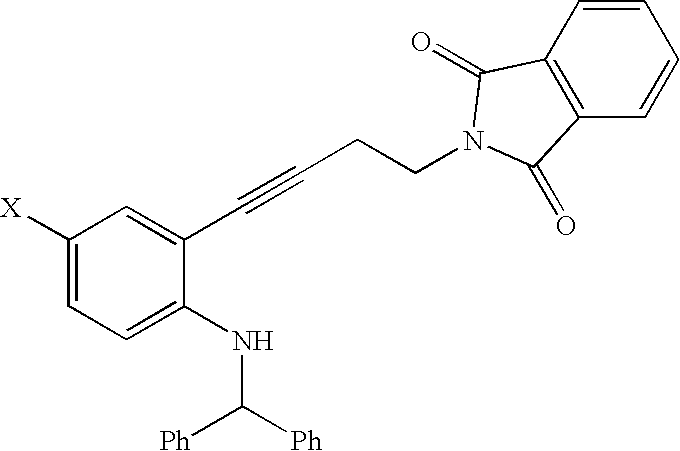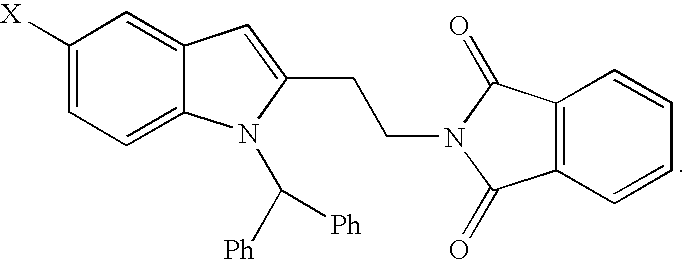Process for the synthesis of a CPLA2 inhibitor
a technology of cpla2 inhibitor and synthesis process, which is applied in the field of synthesis of cpla2 inhibitor, can solve the problem of inpracticality of laboratory-based synthesis processes
- Summary
- Abstract
- Description
- Claims
- Application Information
AI Technical Summary
Benefits of technology
Problems solved by technology
Method used
Image
Examples
example 1
SYNTHESIS OF BENZHYDRYL-(4-CHLORO-2-IODO-PHENYL)-AMINE
To a nitrogen purged 2 L three necked flask equipped with addition funnel, overhead stirrer and reflux condenser was charged 150 g(0.591 mol) 4-Chloro-2-iodo-phenylamine, 3 g(0.018 mol, 0.03 eq) benzenesulfonic acid and 500 mL acetontrile. The mixture was warmed to 70 C and 120 g (0.652 mol, 1.1 eq) benzhydrol dissolved in 500 mL acetonitrile was added to the stirred warm solution over a period of 7.5 h. After another 4 h, LC analysis showed 95% product and 5% starting material remaining. The mixture was cooled to 25 C and 290 mL water was added dropwise over a period of 30-40 min. Stirring was continued over night at 23 C. The dark purple solid was collected by filtration, washed with 2× withMeCN / water 1 / 1 dried at 50 C in vacuo for 15 h to give 218.5 g (88%) product.
1H NMR (300 MHz, DMSO-d6): δ=5.02 (d, j=5.9 Hz, 1H), 5.78 (d, j=5.9 Hz, 1H), 6.45 (d, j=8.9 Hz, 1H), 7.16 (dd, j=8.9, 2.4 Hz, 1H), 7.24-7.42 (m, 10H), 7.71 (d, j...
example 2
SYNTHESIS OF 2-{4-[2-(BENZHYDRYL-AMINO)-5-CHLORO-PHENYL]-BUT-3-YNYL}-ISOINDOLE-1,3-DIONE
5 g(11.93 mmol, 1 eq) benzhydryl-(4-chloro-2-iodo-phenyl)-amine made in Example 1 was combined with 5 mL DMF. 0.42 g(0.598 mmol, 0.05 eq) dichlorobis-(triphenylphosphine)-palladium, 0.24 g(1.26 mmol, 0.11 eq) copper iodide and 1.8 g (17.58 mmol, 1.5 eq) triethylamine were added. The mixture was stirred at 25 C and 2.72 g (13.65 mmol, 1.14 eq) 2-but-3-ynyl-isoindole-1,3-dione was added in one portion. The mixture warmed to 40 C and was cooled back to room temperature. It became semi-solid after 2 h; an LC showed that at this time the reaction was complete. The mixture was diluted with 10 mL DMF and then 5 mL water was added slowly. Stirring was continued until solids precipitated. The vessel was cooled to 0-5 C and stirred at this temperature for 30 min. The resulting solid was collected by filtration and washed with 10 mL DMF / water 2:1 and 2×10 mL MeOH. The 8.78 g wet solid was dried at 40 C in...
example 3
SYNTHESIS OF 2-[2-(1-BENZHYDRYL-5-CHLORO-1H—INDOL-2-YL)-ETHYL]-ISOINDOLE-1,3-DIONE
To a solution of 2-{4-[2-(Benzhydryl-amino)-5-chloro-phenyl]-but-3-ynyl}-isoindole-1,3-dione made in Example 2 (13.1 g, 26.7 mmol) in dimethylformamide (65 ml) at ambient temperature was added copper iodide (1.02 g, 5.3 mmol). The reaction mixture suspension was heated at 120 C for 16 h. Then it was heated at 140 C for 4 h. The reaction mixture was filtered at 60° C. Water (200 ml) was added to the filtrate. The product was collected after filtration and washing with water (20 ml×4). Drying the product in vacuo at 60° C. provided an off-white solid product, 2-[2-(1-Benzhydryl-5-chloro-1H-indol-2-yl)-ethyl]-isoindole-1,3-dione (12.5 g, yield 95%). HPLC (area %): 97.3%
1H NMR (300 MHz, DMSO-d6): δ=3.11 (t, 2H, J=7.0 Hz), 3.90 (t, 2H, J=7.0 Hz), 6.36 (s, 1H), 6.53 (d, 1H, J=8.9 Hz), 6.80 (dd, 1H, J=8.9, 2.1 Hz), 7.14 (m, 4H), 7.20 (s, 1H), 7.34 (m, 6H), 7.47 (d, 1H, J=2.1 Hz), 7.85 (m, 4H).
PUM
 Login to View More
Login to View More Abstract
Description
Claims
Application Information
 Login to View More
Login to View More - Generate Ideas
- Intellectual Property
- Life Sciences
- Materials
- Tech Scout
- Unparalleled Data Quality
- Higher Quality Content
- 60% Fewer Hallucinations
Browse by: Latest US Patents, China's latest patents, Technical Efficacy Thesaurus, Application Domain, Technology Topic, Popular Technical Reports.
© 2025 PatSnap. All rights reserved.Legal|Privacy policy|Modern Slavery Act Transparency Statement|Sitemap|About US| Contact US: help@patsnap.com



